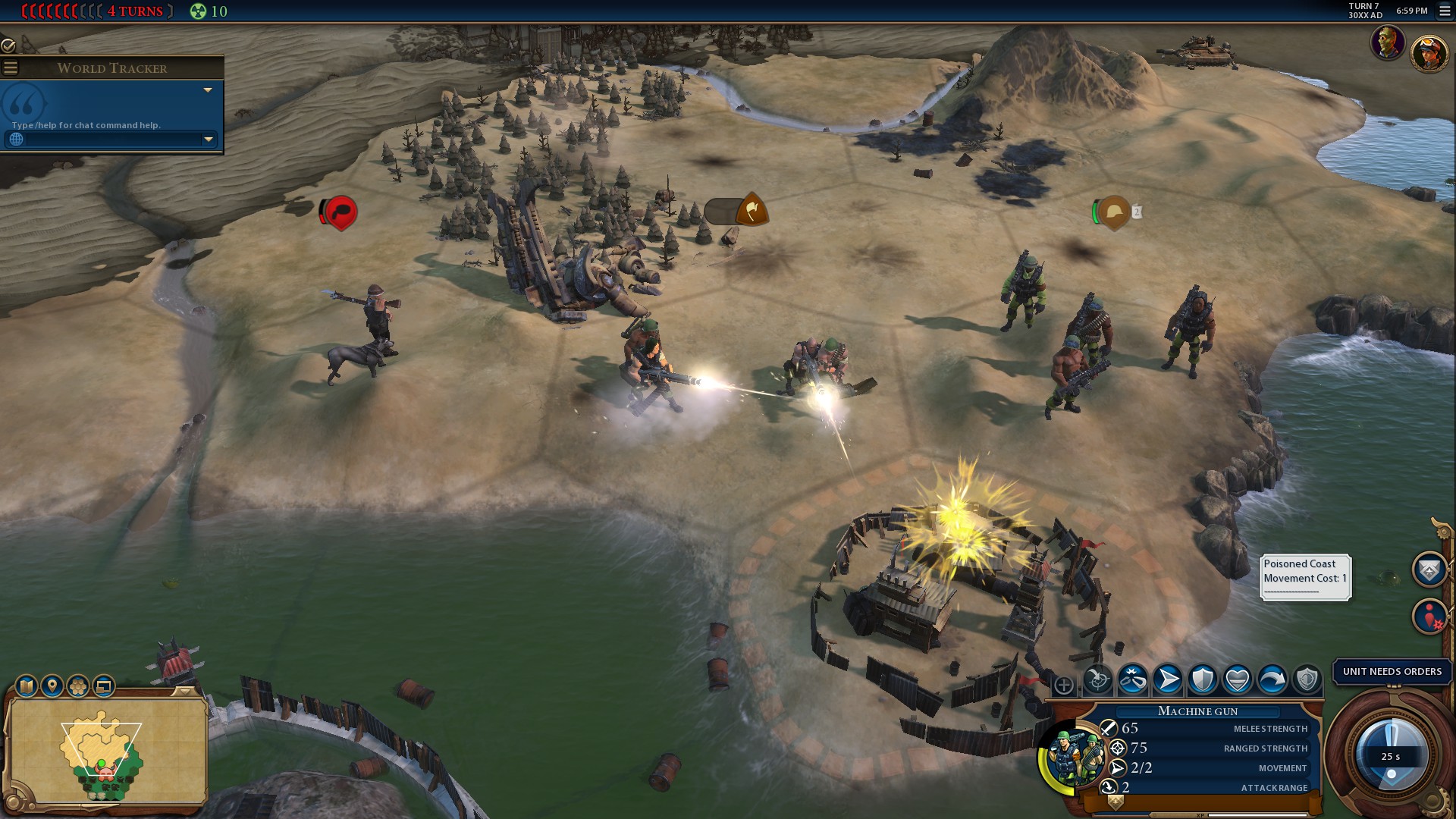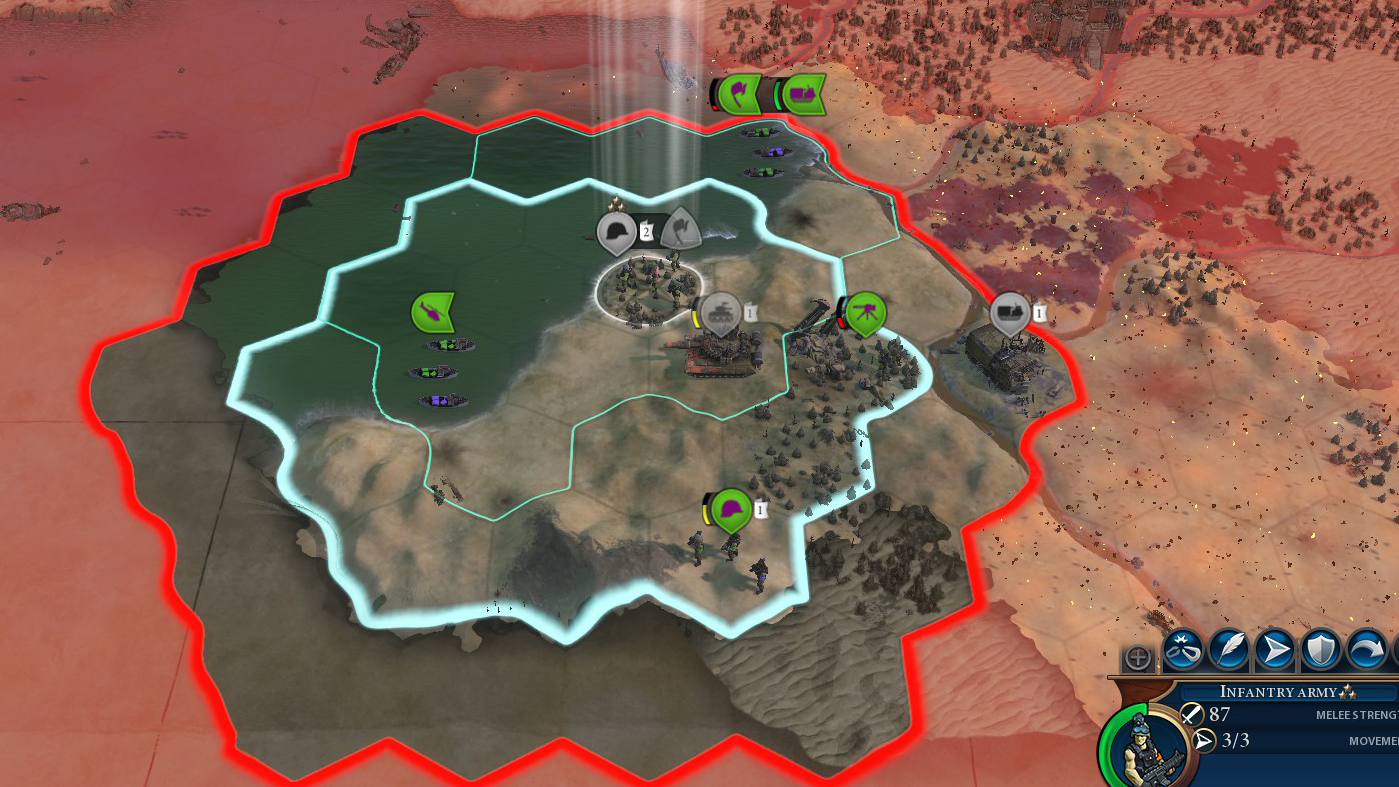Civilization 6 battle royale ditches the civs and cities but keeps the nukes
Red Death, the new turn-based battle royale mode for Civ 6, starts out slow but gets more fun as the circle closes.
Battle royale, of all things, is coming to Civilization 6 today. The new turn-based battle royale mode, Red Death, is set in a post-apocalyptic wasteland of poisoned oceans, ruined cities, and a shrinking circle of deadly radiation. Red Death supports up to 12 players per match (though you can play with as few as two), and you can play against other people, against AI opponents, or a mix of both. Red Death is free if you already own Civ 6.
Six of us played a long and fairly uneventful single match of Red Death together last week, the highlight of which was Tyler nuking the crap out of James. I also played a few additional rounds against AI opponents over the weekend. It's a strange mode for Civ, really, especially considering you don't build civilizations. You don't build anything at all, in fact. Here's how Red Death works—and here's what doesn't work that well.
Each player begins somewhere on the wasteland map with an infantry unit, a machine gun unit, and a civilian unit. It's the civilian unit that is most vulnerable and most important. Your civilian has no attack ability—they're just driving around in a junky-looking truck—and if they're killed or captured it's an instant game over for you, no matter how many other combat units you have at the time. The goal is to be the last player on the map with a civilian unit, at which point a spacecraft lands and takes your civilian off the ruined planet to the safety of an orbiting space station. It doesn't sound that much like Civ, huh?

Each player takes their movement turn simultaneously, though combat happens in a more traditional turn-based format. Creeping across the map takes time, a long time, with most units only moving a couple of hexes in a single turn. Even with six of us playing on a small map, we almost never ran into or even saw each other during our match, so it was all very slow and uneventful at the start of the round as we spread out, fought against a few AI raider units, and began the Civ version of looting for gear.
There are a few ways to increase your power. You'll come across ruined cities you can drive right into, you can attack and invade AI strongholds, or you can be the first player to reach an airdrop. Your reward might be an additional civilian unit, a helicopter, a tank, additional infantry or gunners, and so on. Sometimes you'll just find some additional XP you can use to promote your units, which opens up a very small skill tree to buff their abilities. If you have two matching combat units, you can link them together to form more powerful squadrons. Link another, and your squad becomes an army.
And sometimes you'll find a damn nuclear warhead you can launch to do heavy damage against an enemy—though even the nuke isn't fatal if the unit you're targeting is at full health. The nuke also leaves a sizable area of the map irradiated for several turns, sort of like Civ's version of PUBG's red zones.
You can link a combat unit to your civilian to act as an escort, which I would definitely recommend. If your civilian is alone, all it takes is an enemy unit to occupy the same hex to capture it and end your game (if it's your only civilian). Using a combat unit as an escort means that unit will have to be defeated before you civilian can be captured.
The biggest gaming news, reviews and hardware deals
Keep up to date with the most important stories and the best deals, as picked by the PC Gamer team.
The closing circle of Red Death, at first, feels incredibly slow. Beginning on the very fringes of the map it can be ages before you even see the edges of the red circle. There's a timer telling you when it's going to begin closing, and you're shown the area it will close around as it advances a single hex per turn.
But once it's closed in a bit the Red Death becomes a major threat. If you're fleeing the circle and run into enemies or difficult terrain, or if you're trying to capture an airdrop and get caught in it, the Red Death can really make a mess of your units. If several players are still alive near the end of the match it can become a massive traffic jam. Trying to navigate, protect civilians, and battle other players or AI enemies in the tiny handful of remaining safe hexes is fun in the late-game, and about as much fun as Red Death gets (nuking someone is also fun). It just takes a long, slow, sluggish match to get to the good part.

There are eight different factions to choose from, which give you a few different buffs. Borderlords have greater combat strength when within a few hexes of the safe zone border. Wanderers have a movement bonus through tough terrain. Preppers gain more XP, allowing their units to level up more quickly. Mutants are hurt less by the Red Death and have a movement bonus while inside it, and Pirates don't take as much damage while traveling through the poisonous oceans. Probably the best factions are the Cultists, who have +3 sight, allowing them to peer deeper into the fog of war and spot other players before they see you, or the Mad Scientists, whose units heal twice as fast as other factions.
While the early game feels incredibly slow and not terribly interesting, I've had some fun with Red Death when it comes down to the final few factions crammed into a tiny safe zone near the end of the match. While Red Death definitely doesn't feel like a reason to buy Civ 6, I would recommend at least trying it if you already do own it, even if it's just some matches against the AI. If you're playing a large match, I'd also suggest choosing a smaller map than you think you need, or you might never even see each other until the end.

If there's something missing in the build we played, it's the option to allow players to spectate the remainder of the match once they've been knocked out. As the host of our match, I had to sit there staring at blank screen after I got knocked out early because I was afraid that if I quit to the menu, the match would end for everyone else. But there's a good amount of match customization available otherwise, from changing the turn timer to specifying map size and even map type and features.

Chris started playing PC games in the 1980s, started writing about them in the early 2000s, and (finally) started getting paid to write about them in the late 2000s. Following a few years as a regular freelancer, PC Gamer hired him in 2014, probably so he'd stop emailing them asking for more work. Chris has a love-hate relationship with survival games and an unhealthy fascination with the inner lives of NPCs. He's also a fan of offbeat simulation games, mods, and ignoring storylines in RPGs so he can make up his own.

